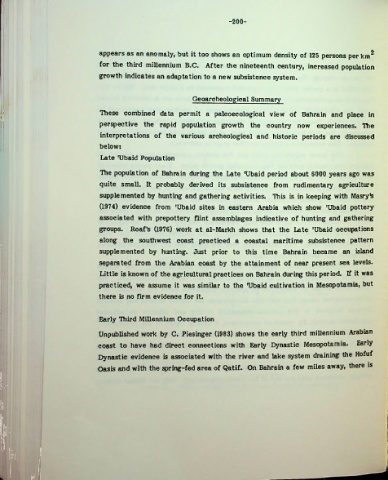Page 224 - Life & Land Use on the Bahrain Islands (Curtis E Larsen)
P. 224
' _
-200-
appears as an anomaly, but it too shows an optimum density of 125 persons per km2
for the third millennium B.C. After the nineteenth century, increased population
growth indicates an adaptation to a new subsistence system.
Geoarcheological Summary
These combined data permit a paleoecological view of Bahrain and place in
perspective the rapid population growth the country now experiences. The
interpretations of the various archeological and historic periods are discussed
below:
Late TJbaid Population
Tbe population of Bahrain during the Late TJbaid period about 6000 years ago was
quite small. It probably derived its subsistence from rudimentary agriculture
supplemented by hunting and gathering activities. This is in keeping with Masry^s
(1974) evidence from 'Ubaid sites in eastern Arabia which show 'Ubaid pottery
associated with prepottery flint assemblages indicative of hunting and gathering
groups. Roaf's (1976) work at al-Markh shows that the Late 'Ubaid occupations
along the southwest coast practiced a coastal maritime subsistence pattern
*
supplemented by hunting. Just prior to this time Bahrain became an island
separated from the Arabian coast by the attainment of near present sea levels.
Little is known of the agricultural practices on Bahrain during this period. If it was
practiced, we assume it was similar to the TJbaid cultivation in Mesopotamia, but
there is no firm evidence for it.
Early Third Millennium Occupation
Unpublished work by C. Piesinger (1983) shows the early third millennium Arabian
coast to have had direct connections with Early Dynastic Mesopotamia. Early
Dynastic evidence is associated with the river and lake system draining the Hofuf
Oasis and with the spring-fed area of Qatif. On Bahrain a few miles away, there is

